It looks like you're using an Ad Blocker.
Please white-list or disable AboveTopSecret.com in your ad-blocking tool.
Thank you.
Some features of ATS will be disabled while you continue to use an ad-blocker.
share:
This will be an examination of the Mystery Cults of the Kingdom of Ta Seti in Northern Sudan with its capital at Qustul and the Naqada culture of
Abydos in Southern Egypt during the pre-Dynastic era, a period extending some 6,000 years into the past.
The area in question then is what went on to become the 1st and 2nd cataracts of Dynastic Egypt in 3,200 BC..
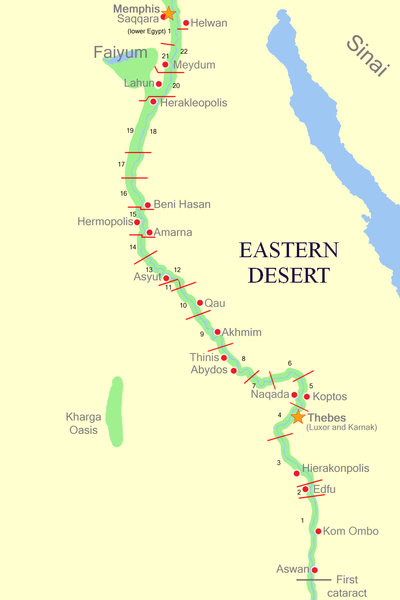
The study will be of the principle Deities, their relationship to archaeo-astronomy, the nature of their cults including the possibility of human sacrifice and the drinking of the victims blood in order to achieve immortality.
The way i will go about this is first to state my case and then explain my reasonings, the majority of the images involved have been sourced from the wonderful website of Francesco Raffaele;
xoomer.virgilio.it...
Some general information on the Anu people of Ta Seti here;
wysinger.homestead.com...
As with many of my threads this is going to involve magical mountains and gates of the horizon...lots of them.
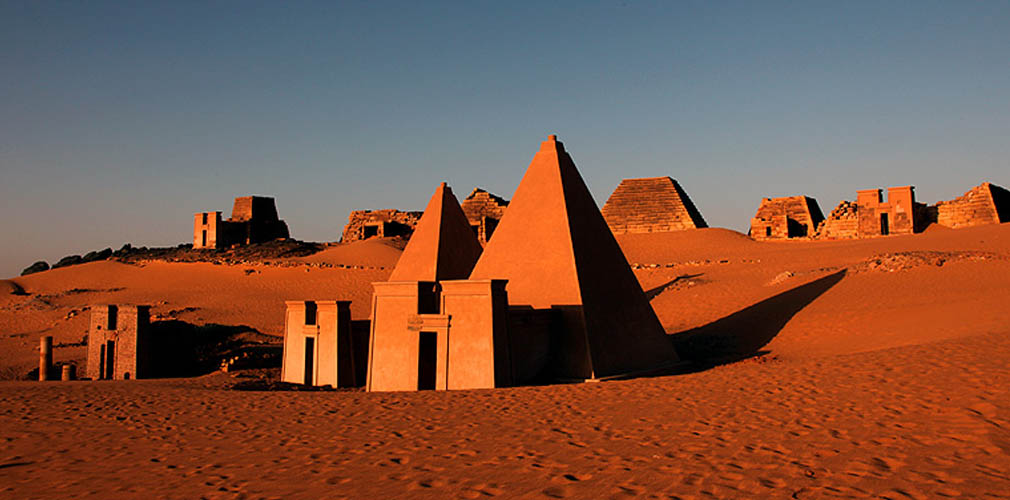
There were two principle Deities of the period, a male and a female, for reasons to be explained i shall refer to the male as Sah the female as Sopdet, names determined from the Dynastic era, but these are their proto-types.
Seen here the male Deity Sah is to the left of the Lion, the female Sopdet to the right, entirely in plant form.
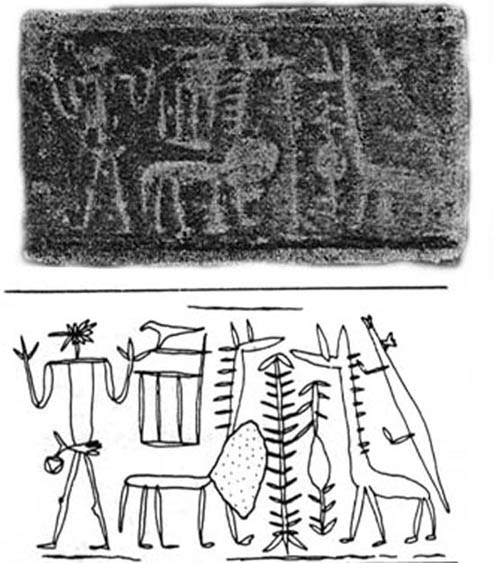
Again below we see the male Deity Sah, this time in association with four lesser Deities or children, to whom he is literally connected.
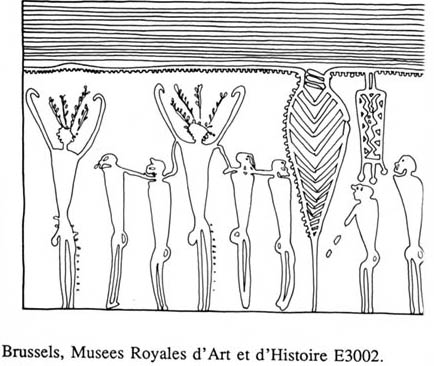
Here's another one one him, this time in conjunction with his consort or daughter, also importantly seen is a stepped mountain of the horizon, his relationship to plants, as will be explained probably viticulture, is prominent.
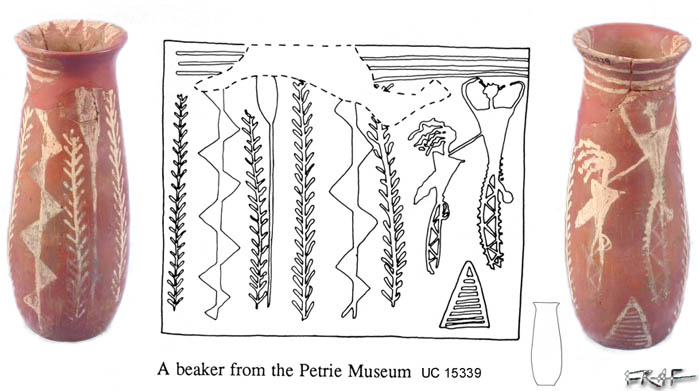
Below we see the female consort Sopdet, here in more human form but still having plant characteristics, she is seen with two children to her left side, and two children to her right side, again then probably the four children that were seen in conjunction with Sah.
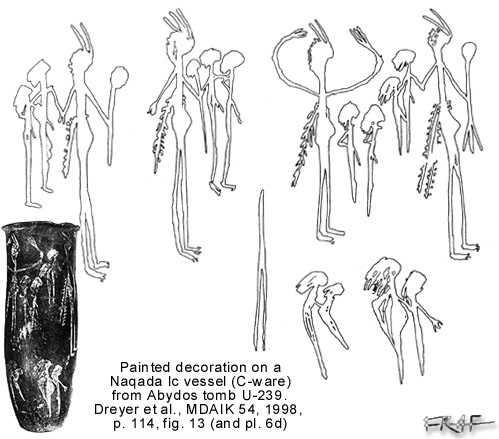
The two principle Deities found correspondance in the Heavens, Sah was the constellation Bootes, with his principle star Arcturus, his consort Sopdet was the constellation Virgo, with her principle star Spica, this is the relationship they formed;
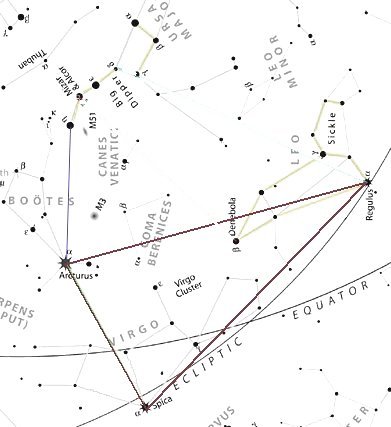
and here is Sah showing his dominion over this triangular relationship, with plant motifs either side. To note here are the mountains of the horizon around the bowl, and that the probably four children of Sah are seen in animal form, maybe bovine.
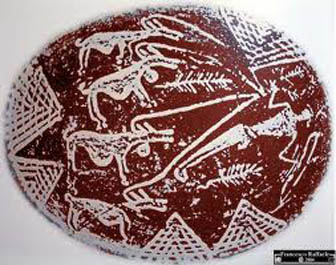
At this point i'll move on to the mountains of the horizon, this was determined by the pyramid shaped cone of light that appears shortly before dawn and after sunset in conjunction with the ecliptic plane. The interest then was in a singular mountain of the horizon as a place of magical transformation, but thismountain was seen to track along the horizon, between the solstice extremeties of the ecliptic plane, and thus it could mark out the horizon in terms of multiple points of rising/setting.
The relationship of this mountain as corresponding to the point of passage of a celestial way went on to become all important in Egyptian afterlife beliefs, and is clearly seen also in the pre-Dynastic period;
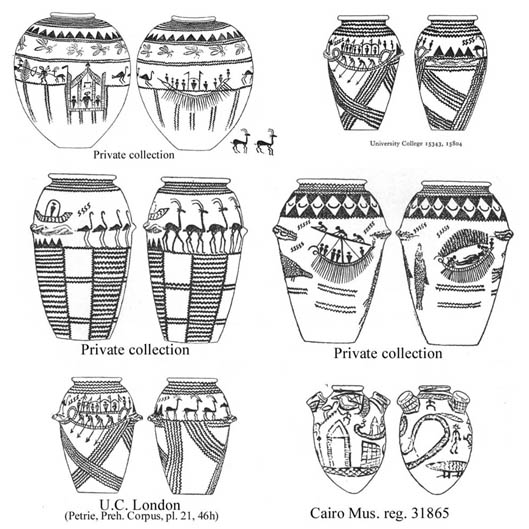
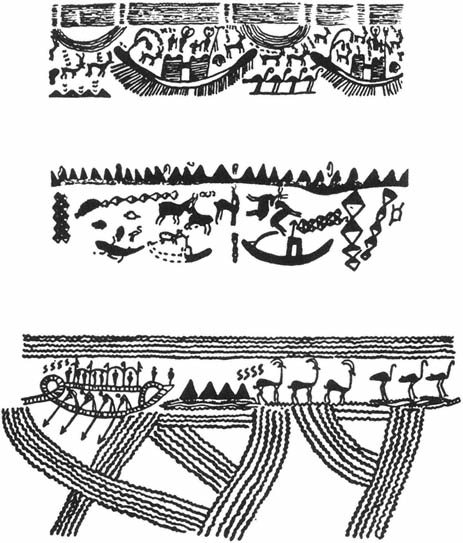
There is the example ff also from Qustul of the stepped mountain motif painted on an ostrich shell, seen in conjunction with a giraffe...
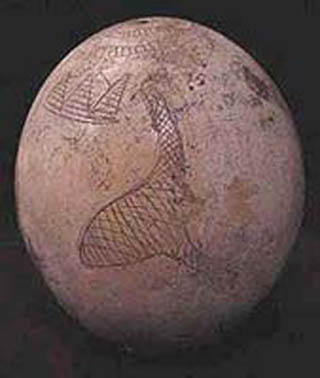
Th giraffe appears to have been a constellation, it was seen in the Sah-Lion-Sopdet example, alongside what i would take to be the constellation VIrgo.
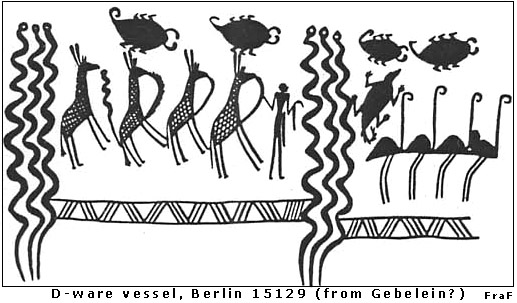
The flamingo seems to have had association with the tree of life in conjunction with the primeval mound of first creation at this early period;
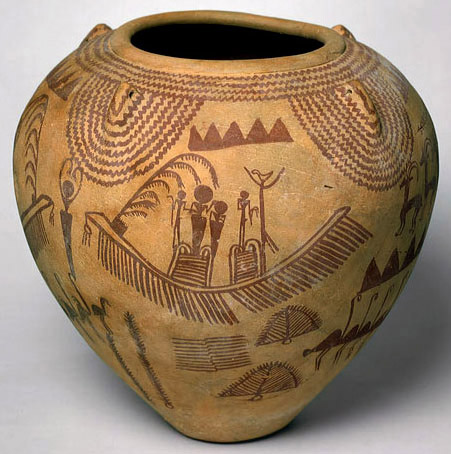
The primeval mound is at the basis of the mountain of the horizon place of transformation.
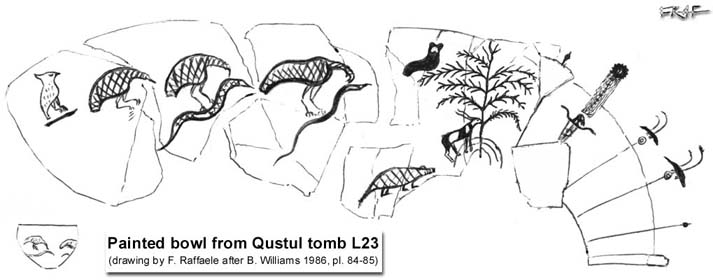
In Qustul ceramics the most common motif is the banding of the mountain of the horizon, in conjuction with a symbol for linkage, but also importantly seen is the banding of gates, as in the back/right example below.
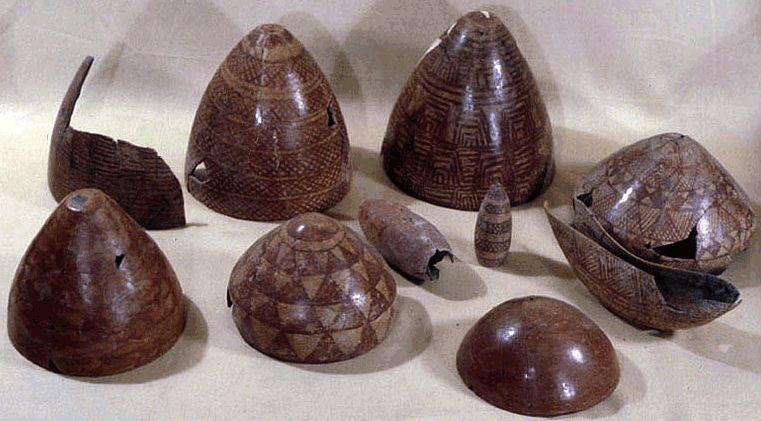
Were there is a mountain of the horizon then there will also be a corresponding gate, an architectural feature. The gates can be seen to develop into the Serekh of Dynastic Egypt, the feature understood as the Palace Facade and its gates, always related to the horizon.
From Qustul we see the relationship of these gates to points of passage on the celestial waterway on an incense burner;
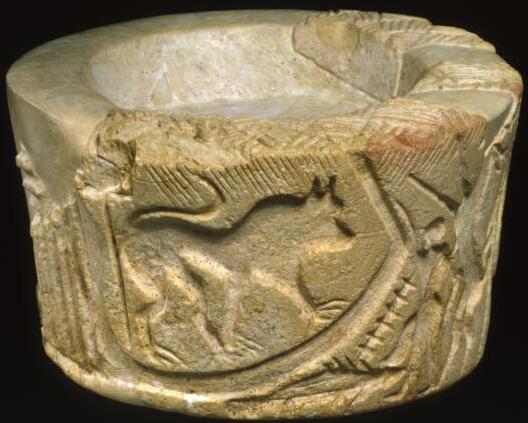

We see also our viticulture Deity Sah to the left with arm raised in conjunction with other astral motifs, the lion gets to go on the boat;

The King in these journeys wears what became known as the White Crown of Upper Egypt, which also went on to become assosciated with Osiris, some thus looking to find his origins in this region and period, but more likely is that he absorbed the earlier traditions when his cult became prominent, but it does support the afterlife cult of Dynastic Egypt seeing its earliest developments in this region.
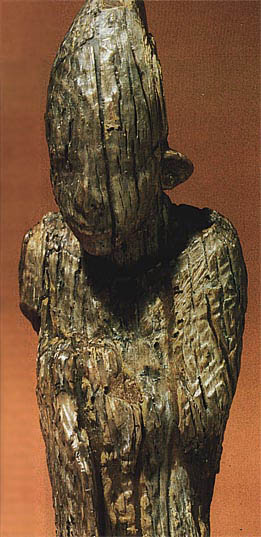
In terms of the gate of the horizon and the proto-serekh these two images caught my attention because of the figure seen in conjunction;
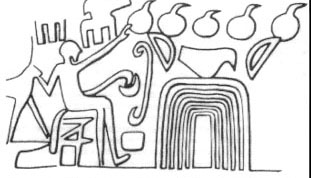
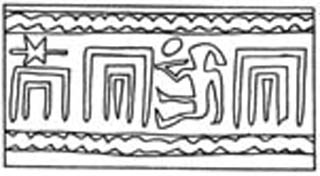
This figure seen in conjunction with the Serekh reminded me of seal impressions i had studied from the earliest Egyptian Dynasties, were i had identified a falling and rising figure seen in conjunction with the Horus name Serekh and sceptre of power motif, were the King was thus identifying himself with Sah.
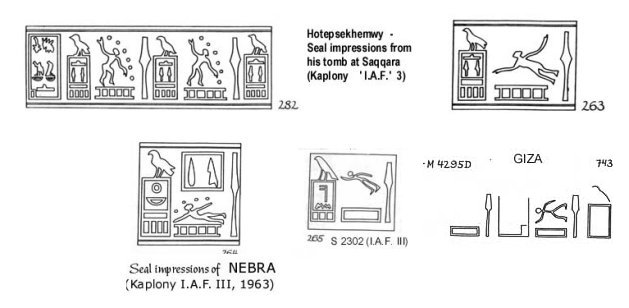
The reason the King should want to do this is found in the so called 'Cannibal Hymn' from the Pyramid Texts;
Evidence from the later period is a cult of Sah were the great one fell on his side and then arose again in power, this could be a metaphor for death and resurrection in the afterlife;
The area in question then is what went on to become the 1st and 2nd cataracts of Dynastic Egypt in 3,200 BC..

The study will be of the principle Deities, their relationship to archaeo-astronomy, the nature of their cults including the possibility of human sacrifice and the drinking of the victims blood in order to achieve immortality.
The way i will go about this is first to state my case and then explain my reasonings, the majority of the images involved have been sourced from the wonderful website of Francesco Raffaele;
xoomer.virgilio.it...
Some general information on the Anu people of Ta Seti here;
wysinger.homestead.com...
As with many of my threads this is going to involve magical mountains and gates of the horizon...lots of them.

There were two principle Deities of the period, a male and a female, for reasons to be explained i shall refer to the male as Sah the female as Sopdet, names determined from the Dynastic era, but these are their proto-types.
Seen here the male Deity Sah is to the left of the Lion, the female Sopdet to the right, entirely in plant form.

Again below we see the male Deity Sah, this time in association with four lesser Deities or children, to whom he is literally connected.

Here's another one one him, this time in conjunction with his consort or daughter, also importantly seen is a stepped mountain of the horizon, his relationship to plants, as will be explained probably viticulture, is prominent.

Below we see the female consort Sopdet, here in more human form but still having plant characteristics, she is seen with two children to her left side, and two children to her right side, again then probably the four children that were seen in conjunction with Sah.

The two principle Deities found correspondance in the Heavens, Sah was the constellation Bootes, with his principle star Arcturus, his consort Sopdet was the constellation Virgo, with her principle star Spica, this is the relationship they formed;

and here is Sah showing his dominion over this triangular relationship, with plant motifs either side. To note here are the mountains of the horizon around the bowl, and that the probably four children of Sah are seen in animal form, maybe bovine.

At this point i'll move on to the mountains of the horizon, this was determined by the pyramid shaped cone of light that appears shortly before dawn and after sunset in conjunction with the ecliptic plane. The interest then was in a singular mountain of the horizon as a place of magical transformation, but thismountain was seen to track along the horizon, between the solstice extremeties of the ecliptic plane, and thus it could mark out the horizon in terms of multiple points of rising/setting.
The relationship of this mountain as corresponding to the point of passage of a celestial way went on to become all important in Egyptian afterlife beliefs, and is clearly seen also in the pre-Dynastic period;


There is the example ff also from Qustul of the stepped mountain motif painted on an ostrich shell, seen in conjunction with a giraffe...

Th giraffe appears to have been a constellation, it was seen in the Sah-Lion-Sopdet example, alongside what i would take to be the constellation VIrgo.

The flamingo seems to have had association with the tree of life in conjunction with the primeval mound of first creation at this early period;

The primeval mound is at the basis of the mountain of the horizon place of transformation.

In Qustul ceramics the most common motif is the banding of the mountain of the horizon, in conjuction with a symbol for linkage, but also importantly seen is the banding of gates, as in the back/right example below.

Were there is a mountain of the horizon then there will also be a corresponding gate, an architectural feature. The gates can be seen to develop into the Serekh of Dynastic Egypt, the feature understood as the Palace Facade and its gates, always related to the horizon.
From Qustul we see the relationship of these gates to points of passage on the celestial waterway on an incense burner;


We see also our viticulture Deity Sah to the left with arm raised in conjunction with other astral motifs, the lion gets to go on the boat;

The King in these journeys wears what became known as the White Crown of Upper Egypt, which also went on to become assosciated with Osiris, some thus looking to find his origins in this region and period, but more likely is that he absorbed the earlier traditions when his cult became prominent, but it does support the afterlife cult of Dynastic Egypt seeing its earliest developments in this region.

In terms of the gate of the horizon and the proto-serekh these two images caught my attention because of the figure seen in conjunction;


This figure seen in conjunction with the Serekh reminded me of seal impressions i had studied from the earliest Egyptian Dynasties, were i had identified a falling and rising figure seen in conjunction with the Horus name Serekh and sceptre of power motif, were the King was thus identifying himself with Sah.

The reason the King should want to do this is found in the so called 'Cannibal Hymn' from the Pyramid Texts;
The sky quivers, the earth quakes before me, for I am a magician, I possess magic
For the King is a great Power who has great Power over the Powers
The King is a sacred image the most sacred of the sacred images of the Great One
And whomsoever he finds in his way him he devours piecemeal(?).
The King's place is at the head of all the august ones who are in the horizon,
for the King is a god, older than the oldest.
Thousands serve him hundreds offer to him,
there is given to him a warrant as Great Power by Sah, father of the Gods.
The King has appeared again in the sky. He is crowned as Lord of the horizon;
He has broken the back-bones
And has taken the hearts of the gods
Evidence from the later period is a cult of Sah were the great one fell on his side and then arose again in power, this could be a metaphor for death and resurrection in the afterlife;
This Great One has fallen on his side, he who is in Nedit is felled.
Your hand is taken by Ra, your head is lifted up by the Two Enneads.
Behold, he has come as sah, behold, Osiris has come as sah,
The sky reels, the earth quakes,
Horus comes, Thoth appears, they raise Osiris from upon his side
and make him stand up in front of the Two Enneads.
edit on 14-3-2013 by Kantzveldt because: (no reason given)
As seen the cult of Sah was an astral cult, the figure with the raised arm, who falls only to rise again;
I identified the figure in the early Dynastic seals with the constellation Bootes, as three priciple stars rise on the horizon in an horizontal position, and when setting these three are upright, having roated anti-clockwise around celestial North, thus a rising position of fallen Sah;
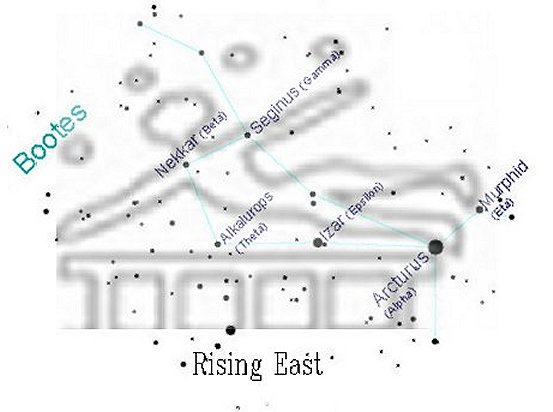
and a setting position of Sah triumphant in the West, a figure that overcomes death,
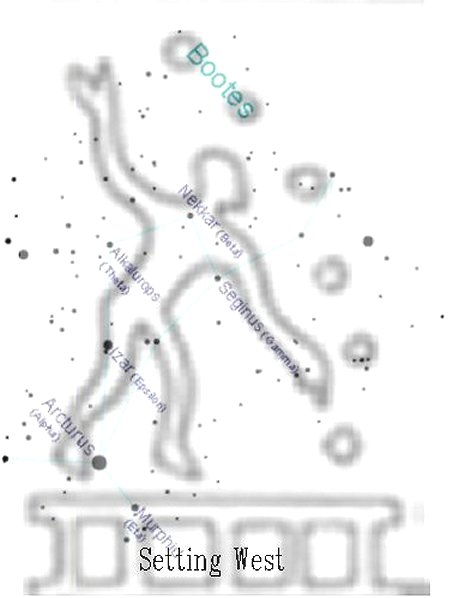
The relationship of Sah is always with Sopdet,
There was a triangular relationship between Sah and Sopdet and Regulus in Leo were the sun rose at the summer solstice in early Dynastic Egypt, the sun/Re thus being seen to rise eternally between these two,
Thus during the Dynastic period this triangular motif had symbolic function,
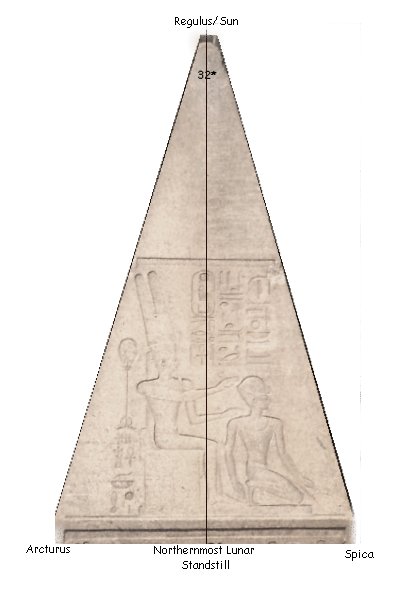
The constellation Bootes throughout the Mesiterranean region and the Near East and Egypt has had association with viticulture due to its seasonal risings, likewise Virgo has had association as a grain Goddess, two principle agricultural Deities, but its the association with wine and blood that i'll now look at
There are representations of blood being gathered in a bowl from a sacrificial victim, this in conjunction with the ladder motif and funerary practise;
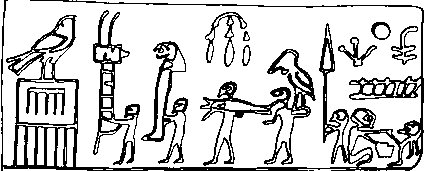
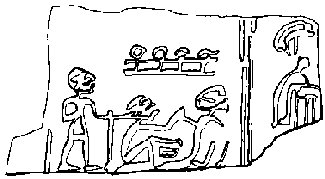
we see a figure with a staff overseeing this, and a figure stirring the pot;
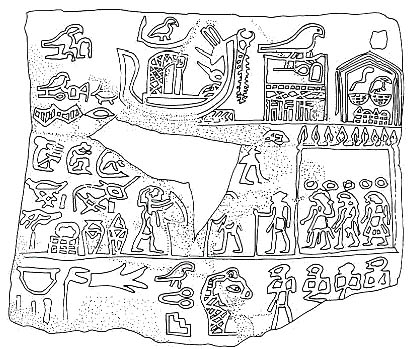
Also seen in this context is a Lion idol in the form of a sphinx, somewhat surprisingly...
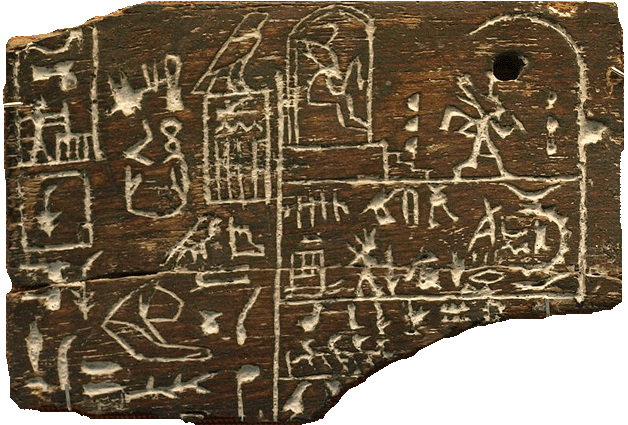
The figure gathering the blood and preparing it would in the Dynastic period be known as Shemzu, an aspect of the cult of Osiris;
www.touregypt.net...
The evidence would suggest that from the Pre-Dynastic Period up until the beginings of the First Dynasty that ritual killing and usage of blood sacrifice was an aspect of the Afterlife Cults of the Period, the sign involved in both killings from the labels of Aha and Djer is the 'ladder' sign, associate with the Sah figure above it, from the Second Dynasty seals. The seal of Djer appears to show the transition of a bound corpse carried in funerary procession, to being shown held upright
The mystical association between wine and blood and resurrection having quite a long history then...based upon a cult of Bootes/Bacchus/Dionysos/Sah.
Hope this helped give some insight
I have gone up among the great ones, I have descended among the sheswe;
I have gone up upon the ladder
with my foot on sah and my arm uplifted.
The elder one fell on his side but stood up as a god, his control with him and his crown atop him
Raise yourself because of your strength, may you ascend to the sky,
may the sky give birth to you like sah, may you have power in your body
May I soar cloudwards to the sky like a heron,
may I surpass the side-locked ones of the sky,
I identified the figure in the early Dynastic seals with the constellation Bootes, as three priciple stars rise on the horizon in an horizontal position, and when setting these three are upright, having roated anti-clockwise around celestial North, thus a rising position of fallen Sah;

and a setting position of Sah triumphant in the West, a figure that overcomes death,

The relationship of Sah is always with Sopdet,
Sopdet has caused me to fly up to the sky
Into the company of my brethren the gods,
My sister is Sopdet,
Never again will the sky be void of me,
Never again will the earth be void of me
There was a triangular relationship between Sah and Sopdet and Regulus in Leo were the sun rose at the summer solstice in early Dynastic Egypt, the sun/Re thus being seen to rise eternally between these two,
The reed-floats of the sky are set in place for Re, the reed-floats of the sky are set in place for Re, that he may be on high from the east to the west in company with his brethren the gods. His brother is sah, his sister is sepdet, and he sits between [them] in this land for ever. The reed-floats of the sky are set in place for this King, the reed-floats of the sky are set in place for this King, that he may be on high from the east to the west in company with his brethren the gods. His brother is sah, his sister is sepdet, and he sits between them in this land for ever.
The sky is pregnant of wine,
Nut has given birth to her daughter the dawn light,
And I raise myself indeed
My third is Sopdet, pure of seats
Thus during the Dynastic period this triangular motif had symbolic function,

The constellation Bootes throughout the Mesiterranean region and the Near East and Egypt has had association with viticulture due to its seasonal risings, likewise Virgo has had association as a grain Goddess, two principle agricultural Deities, but its the association with wine and blood that i'll now look at
It was said that the Herdsman was the national sign of ancient Egypt, the myth of the dismemberment of Osiris originating in the successive settings of its stars; and that there it was called Bacchus, or Sabazius, the ancient name for Bacchus and Noah; and that Kircher's planisphere showed a Vine instead of the customary figure. Its risings and settings were frequently observed and made much of in all classical days, Hesiod says: "When in the rosy morn Arcturus shines, Then pluck the cluster's from the parent vines" and again, but for a different season of the year: "When from the Tropic, or the winter's 'Sun, Thrice twenty days and night's their course have run; And when Arcturus leave's the main, to rise; a star bright shining in the evening 'skies; Then prune the vine". Roman writers and others have similar references to Bootes, or to Arcturus, as indicating the proper seasons for various farm work, as in the 1st Georgic:"Setting Bootes will afford the signs not obscure".
There are representations of blood being gathered in a bowl from a sacrificial victim, this in conjunction with the ladder motif and funerary practise;
There is some evidence that suggests that human sacrifice was practised during the Predynastic Period and at the beginning of the 1st Dynasty.
The earliest known example of human sacrifice may perhaps be found in Predynastic burials in the south of Egypt, dated to the Naqada II Period. One of the discovered bodies showed marks of the throat having been cut before decapitation took place.
A fragmentary label from the reign of the Horus Aha found at Abydos, and a label dated to the time of Aha's successor, Djer, found at Saqqara, may bear witness to a ritual involving the killing of a human being. In both cases a kneeling figure sticks a long weapon into the chest of a bound victim sitting in front of him. A bowl between the assailant and his victim may have been intended to catch the latter's blood as he bleeds to death. Also present in both cases is some kind of fence-like sign, drawn above the sacrificial scene.
On the label fragment from Aha, a figure of authority, identified by his long stick, observes the killing.


we see a figure with a staff overseeing this, and a figure stirring the pot;

Also seen in this context is a Lion idol in the form of a sphinx, somewhat surprisingly...

The figure gathering the blood and preparing it would in the Dynastic period be known as Shemzu, an aspect of the cult of Osiris;
The connection between wine and blood, and thus between helper god and punishing demon, came from the red wine the Egyptians drank. The white variety of wine appeared in the Middle Kingdom, and was a favourite of the Greeks.
It was this red wine - or blood - that Shesmu offers the pharaoh in the Pyramid Texts and the deceased in their travels. Shesmu had a priesthood from early times, and his cult was especially strong at the Faiyum. He was worshiped at Edfu and Dendera. He was a god found in the stars and a god of the dead. He was the headsman of Osiris, beheader of the condemned who turned their blood into deep red wine. His blood wine went to nourish the pharaoh to give him strength, his wine to quench the thirst of the dear departed
He initially seems to be a fierce underworld deity, but Shezmu was quite helpful to the dead. Although he was a harsh executioner of the wicked, he was also a great protector of the virtuous. Shezmu offered red wine to those who had passed on. Other than wine, he was in charge of earthly objects such as embalming oils, and perfumes.
Among the gods, his job was to use the bodies and blood of the dead to create sustenance for Unas. Osiris was the one who ordered the use of the wicked one’s blood to be turned to wine.
www.touregypt.net...
The evidence would suggest that from the Pre-Dynastic Period up until the beginings of the First Dynasty that ritual killing and usage of blood sacrifice was an aspect of the Afterlife Cults of the Period, the sign involved in both killings from the labels of Aha and Djer is the 'ladder' sign, associate with the Sah figure above it, from the Second Dynasty seals. The seal of Djer appears to show the transition of a bound corpse carried in funerary procession, to being shown held upright
The mystical association between wine and blood and resurrection having quite a long history then...based upon a cult of Bootes/Bacchus/Dionysos/Sah.
Hope this helped give some insight
edit on 14-3-2013 by Kantzveldt because: (no reason given)
Great thread you are easily among my favorite poster so far,yes the southern kingdoms carried on both animal..bulls and human sacrifice until well into the Greek era long after the Kemites did away with the practice and instituted shabti figures,the Hed sed festival was to assure the king was fit to continued to rule if found wanting he was ritualistically killed as late as the meroe era this went on
I'm afraid that your speculations do not match the evidence that these two sites (which are excellent ones, and often referred to) are presenting.
Raffaele himself disagrees with you :
Furthermore, Helwan is a city in northern Egypt, far from Sudan.
The sites you cite have a lot of good information on them -- if you are attempting to put forward a new interpretation, you need to explain why the scholars whose sites you are using (people who can read the language and have seen hundreds of these artifacts) are wrong.
You might also want to verify dates and locations of material, since cultures within one area are likely to have different symbols and philosophies than their neighbors.
Patterns on objects often are derived from known things -- the lovely pots with designs that emulate the best weaving (which are not identified with mountains, as far as I can tell from reading a lot of papers on pottery) are a good example of how people take patterns from one cultural activity and use it in another sense.
Originally posted by Kantzveldt
Seen here the male Deity Sah is to the left of the Lion, the female Sopdet to the right, entirely in plant form.
Raffaele himself disagrees with you :
Finally there is a cylinder seal from Helwan 160.H3 with an anonymous serekh and a human figure beside it; this has his arms raised and the right hand appears to be partly placed in the serekh, just nearby to where the name would be written; A.J. Serrano has thus proposed that this figure could designate the king and his royal name -Horus Ka-
Furthermore, Helwan is a city in northern Egypt, far from Sudan.
The sites you cite have a lot of good information on them -- if you are attempting to put forward a new interpretation, you need to explain why the scholars whose sites you are using (people who can read the language and have seen hundreds of these artifacts) are wrong.
You might also want to verify dates and locations of material, since cultures within one area are likely to have different symbols and philosophies than their neighbors.
Patterns on objects often are derived from known things -- the lovely pots with designs that emulate the best weaving (which are not identified with mountains, as far as I can tell from reading a lot of papers on pottery) are a good example of how people take patterns from one cultural activity and use it in another sense.
edit on 15-3-2013 by Byrd because: (no reason given)
A lot of the images you are showing are not "pictures" but are written documents.
The text on them is perfectly readable if you read hieroglyphs.
I'm curious why you quoted this interpretation (which is correct) and then interpreted it as
Your interpretation of the ivory tablet of Neithotep is also problematical:

This image has, as Raffaele says, been translated. At the top is a serekh topped by Horus, indicating the royal name (I'm not sure if you're trying to identify the Horus as a lion or not.) The object on the lower right has a name associated with it (written right behind it) which seems to be "Heret" -- and a sign that indicates the terraced land or farmland (the "stairsteps" - Gardinier C-14)
There are similar issues elsewhere. Mystery religions are interesting and while there may have been some in ancient Egypt, I don't think that your grouping of these objects from different times and places indicates a mystery religion.
The text on them is perfectly readable if you read hieroglyphs.
There is some evidence that suggests that human sacrifice was practised during the Predynastic Period and at the beginning of the 1st Dynasty.
A fragmentary label from the reign of the Horus Aha found at Abydos, and a label dated to the time of Aha's successor, Djer, found at Saqqara, may bear witness to a ritual involving the killing of a human being. In both cases a kneeling figure sticks a long weapon into the chest of a bound victim sitting in front of him. A bowl between the assailant and his victim may have been intended to catch the latter's blood as he bleeds to death. Also present in both cases is some kind of fence-like sign, drawn above the sacrificial scene.
On the label fragment from Aha, a figure of authority, identified by his long stick, observes the killing.
I'm curious why you quoted this interpretation (which is correct) and then interpreted it as
. The figure you identify as being the one "stirring the pot" is actually the person being executed.
we see a figure with a staff overseeing this, and a figure stirring the pot;
Your interpretation of the ivory tablet of Neithotep is also problematical:

This image has, as Raffaele says, been translated. At the top is a serekh topped by Horus, indicating the royal name (I'm not sure if you're trying to identify the Horus as a lion or not.) The object on the lower right has a name associated with it (written right behind it) which seems to be "Heret" -- and a sign that indicates the terraced land or farmland (the "stairsteps" - Gardinier C-14)
There are similar issues elsewhere. Mystery religions are interesting and while there may have been some in ancient Egypt, I don't think that your grouping of these objects from different times and places indicates a mystery religion.
very well presented thread vK, as usual
always a pleasure to read
one sidenote please,
"Sah " is Orion
as the 4 beasts/children are ' the 4 sons ' [ of Horus]
"Sah " and " nemesah " were both used for Orion [ = thoth ]
hence the "namaste " derives from that word
always a pleasure to read
one sidenote please,
"Sah " is Orion
as the 4 beasts/children are ' the 4 sons ' [ of Horus]
"Sah " and " nemesah " were both used for Orion [ = thoth ]
hence the "namaste " derives from that word
reply to post by Byrd
Helwan is a city in northern Egypt, far from Sudan.
True but what culture was the site associated with, just asking cause I don't know, but if the 1st kings aroused in the south to form a united Kemet wouldn't they have some cultural links to the then defunked Ta-Seti not saying they were expats but wouldn't they have carried a similar tradition.
reply to post by Byrd
Consider the 2nd Dynasty seals i posted, were the figure i associate with Sah is placed inbetween the Serekh Horus name and sceptre of power symbol, thus directly associated with the King. Thus it doesn't indicate the Horus name here, but is making a direct association with the King...my point.
I don't see that at all, the pot stirrer can arguably be related to the overseer with staff, but i see no relationship to the victim.
There are always going to be differant interpretations, evidence is sketchy for the period and limited in quantity and quality. I've tried to keep the presentation within reasonable geographical and temporal constraints whilst trying to put together a picture of the mystery cults seen practised on the artifacts.
So fair enough thats outside my stated geographic area of investigation, helps to show the cults could have extended to that area then.
reply to post by Lone12
Thanks, over the years i've participated and foll0wed many a discussion on why Sah was not Orion in the Old Kingdom, and Pre-Dynastic period.
In my opinion for this period Orion was the falcon Sokar, confusion arises when the cult of Osiris moves into areas of concern of both Sah and Sokar, one of the aspects of Osiris was after the Sumerian shepherd of Anu type representation of Orion
Also consider this;
reply to post by Spider879
Thanks, it interests me how the neccesity of drinking human sacrificial blood to achieve life after death never really went away, its the central theme of the Christian Eucharist of course, eat the body and drink the blood to achieve life everlasting
Finally there is a cylinder seal from Helwan 160.H3 with an anonymous serekh and a human figure beside it; this has his arms raised and the right hand appears to be partly placed in the serekh, just nearby to where the name would be written; A.J. Serrano has thus proposed that this figure could designate the king and his royal name -Horus Ka-
Consider the 2nd Dynasty seals i posted, were the figure i associate with Sah is placed inbetween the Serekh Horus name and sceptre of power symbol, thus directly associated with the King. Thus it doesn't indicate the Horus name here, but is making a direct association with the King...my point.
The figure you identify as being the one "stirring the pot" is actually the person being executed.
I don't see that at all, the pot stirrer can arguably be related to the overseer with staff, but i see no relationship to the victim.
This image has, as Raffaele says, been translated. At the top is a serekh topped by Horus, indicating the royal name (I'm not sure if you're trying to identify the Horus as a lion or not.) The object on the lower right has a name associated with it (written right behind it) which seems to be "Heret" -- and a sign that indicates the terraced land or farmland (the "stairsteps" - Gardinier C-14)
There are similar issues elsewhere. Mystery religions are interesting and while there may have been some in ancient Egypt, I don't think that your grouping of these objects from different times and places indicates a mystery religion.
There are always going to be differant interpretations, evidence is sketchy for the period and limited in quantity and quality. I've tried to keep the presentation within reasonable geographical and temporal constraints whilst trying to put together a picture of the mystery cults seen practised on the artifacts.
Furthermore, Helwan is a city in northern Egypt, far from Sudan.
So fair enough thats outside my stated geographic area of investigation, helps to show the cults could have extended to that area then.
reply to post by Lone12
Thanks, over the years i've participated and foll0wed many a discussion on why Sah was not Orion in the Old Kingdom, and Pre-Dynastic period.
In my opinion for this period Orion was the falcon Sokar, confusion arises when the cult of Osiris moves into areas of concern of both Sah and Sokar, one of the aspects of Osiris was after the Sumerian shepherd of Anu type representation of Orion
Also consider this;
Arkturos is mentioned twice, W. 566 and 610. By Arkturos Hesiod means the same as Homer by Bootes; in later Greek he is also called Arktophylax, and Aratus seems to use Arktophylax for the Constellation, and Arkturos, just as we do, for its brightest star; Arat. Phen. 91 seqq., ‘Behind Helike moves, like to one driving, Arktophylax, whom men also call Bootes, since he appears to lay his hands on the wain-like Bear; all of him is very conspicuous, but under his belt rolls brightly the star Arkturos himself.’ The Schol. on this passage says that Arktophylax was an Arkadian, son of Zeus and Kallisto, and that he was brought up by a goatherd on Mount Lykaion, and being with his mother in danger of his life, Zeus in pity turned him into a star. He adds, ‘This is said to be Arktophylax, Bootes, Orion, . . . and also he is called Trugetes (Vintager). Theon and Hesychios also call Bootes Orion, and it has been suggested that there were two Orions, Bootes being one.
reply to post by Spider879
Thanks, it interests me how the neccesity of drinking human sacrificial blood to achieve life after death never really went away, its the central theme of the Christian Eucharist of course, eat the body and drink the blood to achieve life everlasting
edit on 15-3-2013 by Kantzveldt because: (no reason given)
Hi kanztveldt
Looks looks like I've got my reading for tonight.
Looks looks like I've got my reading for tonight.
Originally posted by Lone12
very well presented thread vK, as usual
always a pleasure to read
one sidenote please,
"Sah " is Orion
as the 4 beasts/children are ' the 4 sons ' [ of Horus]
"Sah " and " nemesah " were both used for Orion [ = thoth ]
hence the "namaste " derives from that word
Could you be specific about the word "Namaste"? Is it the same as in Sanskrit/India?
Originally posted by Lone12
one sidenote please,
"Sah " is Orion
as the 4 beasts/children are ' the 4 sons ' [ of Horus]
"Sah " and " nemesah " were both used for Orion [ = thoth ]
hence the "namaste " derives from that word
Namaste comes from the word that means "to bow". It means "I bow to you."
The gesture is fairly old, but the word, "namaste" hasn't been in use that far back in history. (see Wikipedia which notes the gesture is old but the word is not that old)
Originally posted by Spider879
reply to post by Byrd
Helwan is a city in northern Egypt, far from Sudan.
True but what culture was the site associated with, just asking cause I don't know, but if the 1st kings aroused in the south to form a united Kemet wouldn't they have some cultural links to the then defunked Ta-Seti not saying they were expats but wouldn't they have carried a similar tradition.
Predynastic Egypt was two (and possibly more) separate countries. The site was hundreds of miles from Sudan. While there might have been some trade, the cultures weren't really unified until after King Nemes united Egypt (and even then, there were regional differences in deities and religious practices.)
Originally posted by Kantzveldt
Consider the 2nd Dynasty seals i posted, were the figure i associate with Sah is placed inbetween the Serekh Horus name and sceptre of power symbol, thus directly associated with the King. Thus it doesn't indicate the Horus name here, but is making a direct association with the King...my point.
I believe if you write Raffaele himself, you will learn some interesting things (and remember, he can read the material) -- I also believe that you will find your idea here is not supported (and he can cite a lot of evidence about why it's not supported.) Granted, I haven't studied pre-dynastic Egypt as thoroughly as Raffaele has, but I feel pretty confident that he can show you a lot of other material which bolsters his interpretation.
The figure you identify as being the one "stirring the pot" is actually the person being executed.
I don't see that at all, the pot stirrer can arguably be related to the overseer with staff, but i see no relationship to the victim.
Part of the problem is that you're looking at photos and drawings of an object (not the object itself, where you can look closely through a loupe and turn it over in your hands and examine it from all angles under a strong light.) Since the person who made the identification is a person who handled the real object (and wasn't looking at drawings) and knows the other material it was found with -- AND has seen a lot of Egyptian art -- I think his statement is accurate.
There are always going to be differant interpretations, evidence is sketchy for the period and limited in quantity and quality. I've tried to keep the presentation within reasonable geographical and temporal constraints whilst trying to put together a picture of the mystery cults seen practised on the artifacts.
However, the interpretations you're questioning are by people who have seen the objects themselves and other objects found with them. They're not picking and choosing museum/widely published pieces. They're looking at other things as well, including items which aren't ever shown on the internet (pottery fragments, statue pieces, rubble, housing, rubbish pits, etc.)
Furthermore, Helwan is a city in northern Egypt, far from Sudan.
So fair enough thats outside my stated geographic area of investigation, helps to show the cults could have extended to that area then.
I think if you look at the reports about Helwan more closely, you'll find that this is not the case.
Thanks, over the years i've participated and foll0wed many a discussion on why Sah was not Orion in the Old Kingdom, and Pre-Dynastic period.
In my opinion for this period Orion was the falcon Sokar, confusion arises when the cult of Osiris moves into areas of concern of both Sah and Sokar, one of the aspects of Osiris was after the Sumerian shepherd of Anu type representation of Orion
Again, there's a problem with time. To the Egyptians, Orion was two constellations and not one. Osiris is not as old a deity as Horus and Sokar is even younger. Since the Egyptians were constantly at war with the Sumerians, there's no real reason for them to adopt the iconography of their enemies. (the Crystalinks site gives some support to the idea, but the documents they cite are a century out of date.)
But do check with Raffaele... if he has time to answer, he will provide the additional material that they were looking at which was found in each area and gives a fuller understanding of the context.
reply to post by Byrd
I have corresponded with Raffaele previously enquiring as to the current state of knowledge on various seals and such like, i do value his opinion and resource.
The evidence for Orion being seen as two constellations in the Old Kingdom just isn't there, and your statement regarding Sokar being even younger than Osiris is terribly wrong, given that he was the patron Deity of Saqqara, Giza and Abusir Necropolii...
To help understand the extent of his cult;
pia-journal.co.uk...
In the Old Kingdom Orion was the astral representation of Sokar, as part of the agrarian cycle it corresponded to the onion season;
www.osirisnet.net...
The aspect of the five onions involved in the Sokar Festival dates back to the Pre-Dynastic period

The evidence clearly supports that the oldest association of Orion was with Sokar, and that the correspondance of Osiris with Orion in later periods was his absorbtion into the Sokar cult.
www.rostau.org.uk...
I have corresponded with Raffaele previously enquiring as to the current state of knowledge on various seals and such like, i do value his opinion and resource.
The evidence for Orion being seen as two constellations in the Old Kingdom just isn't there, and your statement regarding Sokar being even younger than Osiris is terribly wrong, given that he was the patron Deity of Saqqara, Giza and Abusir Necropolii...
To help understand the extent of his cult;
The absence of settlement remains in the area clarifies issues concerning the presence of a lake at Abusir. The drill core evidence might support Verner’s (1992) explanation that the absence of funerary architecture between North Saqqara and
Abusir is a response to the existence of a lake at the foot of the Abusir escarpment.
There are two sources of textual references to the Abusir lake. The earliest reference
occurs in utterance 610 (§1712) of the Pyramid Texts as a title or epithet of Sokar,
“Sokar who presides over the Pdw-š” (Faulkner 1969, 253), where Pdw- š is interpreted as the “lake of Abusir” (Gaballa and Kitchen 1969, 5, n.6). Secondly, New
Kingdom and Late period texts cite toponyms from the Memphite Necropolis in association with the sanctuary of Sokar, which is most likely to have been at Saqqara
(Posner-Kriéger 1976, 71, n.1). Thus, the notion of a lake at Abusir was derived
from the translation of the title or epithet of the god Sokar.
The second source of textual references to the Abusir lake is from demotic ostraca,
recovered from The Archive of Hor at Saqqara, where there is mention of the “Lake
of Pharaoh” (Ray 1976, 153). Ray (1976; 1978, 153) concludes that the “Lake of
Pharaoh” confirms the existence of a lake at the foot of the Saqqara-Abusir desert
escarpment. The presence of a lake is considered necessary to breed the sacred ibis
birds, as offerings to the Sacred Animal Necropolis.
pia-journal.co.uk...
In the Old Kingdom Orion was the astral representation of Sokar, as part of the agrarian cycle it corresponded to the onion season;
The agrarian calendar perfectly defines the liturgy: the onions planted at the end of September and picked at the end of October are heralding the arrival of the light and are going to be transplanted in the land to be ready to be chewed at the time of the festival of Bastet, February 5th, as all snakes come out of their hibernation and when the swallows begin to return announcing the summer sun. The small onions, early fruits and vegetables, inhaled to receive a new breath at the time of the ntryt-night, having germinated during the winter period, become witnesses to a source of rebirth to a chthonian life, with the image of a living Sokar in a cave and carrying the solar star in the Duat. The solarisation or light created the 25th and 26th of Khoiak leads to a stellar design (or darkness with appearance of the constellation of Orion)
These five onion bulbs are found in the tables of offerings associated with the opening of the mouth, without which, it is always possible, according to the iconography of the tombs, to affirm that the bundles of onions of Khoiak 25th are formed in multiples of five bulbs. The number five could, however, evoke the opening the two eyes, the two ears and the mouth.
www.osirisnet.net...
The aspect of the five onions involved in the Sokar Festival dates back to the Pre-Dynastic period

The evidence clearly supports that the oldest association of Orion was with Sokar, and that the correspondance of Osiris with Orion in later periods was his absorbtion into the Sokar cult.
Sokar was undoubtedly originally a distinct deity of the Memphite necropolis: r3-sT3.w "Giza" (like the name of this List's server "Rostau" though I would have spelled if "Rosetjau") and pD.w "Saqqara", the modern name of which is believed to come from that of Sokar. There is a possibility that he was actually transplanted to the Memphite region from Busiris or some other Delta location. He represented the fertility that lies at the bottom of the underworld as well as the minerals and vegetal produce of the earth. He was carried on a boat known as the Henu-barque which had the form of a the crescent moon. His stellar manifestation was that of Orion.
www.rostau.org.uk...
edit on 18-3-2013 by Kantzveldt because: (no reason given)
reply to post by Kantzveldt
The real problem here is that you're taking objects out of context and assigning meaning.
Those things aren't just something they found in the desert. They came from burial sites and other sites (temples, etc) and knowing what they are found with tells how they are interpreted.
It's like an alien stumbling across a modern site that has a statue of a black cat -- that statue might be a tourist piece of Bast which was picked up as a tchachke, it might be part of an altar for a Pagan in the Kemetic religion, it might be a piece inherited from a sibling, it might be a "power object" in a ritualist's home, it might have been dropped there to get rid of it long after the place was abandoned, or it might even be a Halloween decoration. You don't know unless you see where it is and what's around it and when it was placed there.
Objects for mystery cults have certain things associated with them and are found in certain contexts. Selecting a set of objects without knowing where they were found and what else they were found with and so forth is going to lead you astray -- like an alien identifying a birthday cake as evidence of a cult which practiced bribery of children.
The real problem here is that you're taking objects out of context and assigning meaning.
Those things aren't just something they found in the desert. They came from burial sites and other sites (temples, etc) and knowing what they are found with tells how they are interpreted.
It's like an alien stumbling across a modern site that has a statue of a black cat -- that statue might be a tourist piece of Bast which was picked up as a tchachke, it might be part of an altar for a Pagan in the Kemetic religion, it might be a piece inherited from a sibling, it might be a "power object" in a ritualist's home, it might have been dropped there to get rid of it long after the place was abandoned, or it might even be a Halloween decoration. You don't know unless you see where it is and what's around it and when it was placed there.
Objects for mystery cults have certain things associated with them and are found in certain contexts. Selecting a set of objects without knowing where they were found and what else they were found with and so forth is going to lead you astray -- like an alien identifying a birthday cake as evidence of a cult which practiced bribery of children.
reply to post by Kantzveldt
BTW, nice material there on Soker and Orion (though the Sah/Orion connection is still dubious.) Appreciate the links -- the "five onions" is something new and interesting to me.
BTW, nice material there on Soker and Orion (though the Sah/Orion connection is still dubious.) Appreciate the links -- the "five onions" is something new and interesting to me.
...one last point...
Take a look at the Dendera Temple ceiling (the most famous star map of ancient Egypt) and then take a look at the map of the northern constellations (here's one of them) Notice that the Big Dipper appears in Dendera as the leg of an animal (similar to the joints of meat that appear in paintings of offerings to the dead) and that the "bowl" (hip of the leg) points roughly to Orion. Notice that at Dendera, no figure of a man/huntsman/pharaoh appears in that section. The "huntsman and dog" on the ceiling is close to where our constellation of Hercules is.
In the area of Orion there is a set of twinned figures as well as a clump that's "two beasts with a bird standing on the head of one of them." I've seen another illustration where it was Isis and a boat, but can't find a reference for that one so I'll pass on that label.
Originally posted by Kantzveldt
The evidence for Orion being seen as two constellations in the Old Kingdom just isn't there,...
Take a look at the Dendera Temple ceiling (the most famous star map of ancient Egypt) and then take a look at the map of the northern constellations (here's one of them) Notice that the Big Dipper appears in Dendera as the leg of an animal (similar to the joints of meat that appear in paintings of offerings to the dead) and that the "bowl" (hip of the leg) points roughly to Orion. Notice that at Dendera, no figure of a man/huntsman/pharaoh appears in that section. The "huntsman and dog" on the ceiling is close to where our constellation of Hercules is.
In the area of Orion there is a set of twinned figures as well as a clump that's "two beasts with a bird standing on the head of one of them." I've seen another illustration where it was Isis and a boat, but can't find a reference for that one so I'll pass on that label.
reply to post by Byrd
Of course one takes into account the greater context in terms of related finds, i tend to concentrate on the iconography though as that's were i have expertise and the capacity to make worthwhile contribution.
At Denderah the representation of Orion is beneath the bull Taurus, next to the Canis cow, the striding shepherd type figure, after the type introduced in the Coffin Texts.
.
Of course one takes into account the greater context in terms of related finds, i tend to concentrate on the iconography though as that's were i have expertise and the capacity to make worthwhile contribution.
At Denderah the representation of Orion is beneath the bull Taurus, next to the Canis cow, the striding shepherd type figure, after the type introduced in the Coffin Texts.
.
Originally posted by Kantzveldt
reply to post by Byrd
Of course one takes into account the greater context in terms of related finds, i tend to concentrate on the iconography though as that's were i have expertise and the capacity to make worthwhile contribution.
So what was the context of these finds that led you to believe they're all associated through distance and time to a Mystery Cult.
At Denderah the representation of Orion is beneath the bull Taurus, next to the Canis cow, the striding shepherd type figure, after the type introduced in the Coffin Texts.
I see the striding figure, but that's a pharaoh wearing the Red Crown and not a shepherd. BUT, with that minor quibble out of the away, I agree that it's underneath Taurus and is therefore likely Orion, though the orientation of Orion in respect to the Dipper is... weird (but consistent with their idea of "decorative rather than highly accurate."
.
reply to post by Byrd
It's the White Crown of Upper Egypt the figure is wearing, and the reason it relates to the Babylonian true shepherd of Anu is the association with the bird.
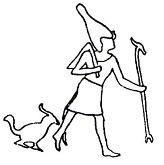
solariapublications.com...
But my point would always be is that isn't how things were seen in the Old Kingdom and Pre-Dynastic era.
My idea of the mystery cults of the pre-Dynastic period, as outlined in the opening post, is that these were associated with agrarian cycles of the year, and correspondant 'gates of the horizon' were the related constellations would appear in due season, viticulture for Bootes, grain for Virgo, Onions for Orion etc, in terms of their Egyptian equivalents of course.
They are 'Mystery Cults' in the sense that they are not simply noting these seasons, but that they are interwoven with metaphysical speculations regarding the stages of creation, and the stages of the life of man including his translation into the afterlife, everything that would be found in the later 'Mystery Cults' of the Classical Period is already speculated upon and determined and never really improved upon.
It's the White Crown of Upper Egypt the figure is wearing, and the reason it relates to the Babylonian true shepherd of Anu is the association with the bird.
..The Babylonian version of Orion is called the True Shepherd of Anu. Although no depictions are known, it is likely that he was portrayed as the messenger to the gods known as Ninšubur or Papšukkal. Star names indicate that he was posed as if walking with one foot and hand extended before him. His symbol of office was a long staff and on entitlement stones he was frequently represented by the figure of a crested walking bird On the Babylonian star-map this bird is characterised as the Rooster, which is located below and behind the figure of the True Shepherd

solariapublications.com...
But my point would always be is that isn't how things were seen in the Old Kingdom and Pre-Dynastic era.
My idea of the mystery cults of the pre-Dynastic period, as outlined in the opening post, is that these were associated with agrarian cycles of the year, and correspondant 'gates of the horizon' were the related constellations would appear in due season, viticulture for Bootes, grain for Virgo, Onions for Orion etc, in terms of their Egyptian equivalents of course.
They are 'Mystery Cults' in the sense that they are not simply noting these seasons, but that they are interwoven with metaphysical speculations regarding the stages of creation, and the stages of the life of man including his translation into the afterlife, everything that would be found in the later 'Mystery Cults' of the Classical Period is already speculated upon and determined and never really improved upon.
new topics
-
Watch as a 12 million years old Crab Emerges from a Rock
Ancient & Lost Civilizations: 1 hours ago -
ILLUMINATION: Dimensions / Degrees – Da Vincis Last Supper And The Philosophers Stone
Secret Societies: 8 hours ago -
Just Sick of It! Done! Can't take it anymore!
General Chit Chat: 9 hours ago -
Speaking of Pandemics
General Conspiracies: 10 hours ago -
Stuck Farmer And His Queue Jumping Spawn
Rant: 10 hours ago
top topics
-
Watch as a 12 million years old Crab Emerges from a Rock
Ancient & Lost Civilizations: 1 hours ago, 9 flags -
Speaking of Pandemics
General Conspiracies: 10 hours ago, 8 flags -
ILLUMINATION: Dimensions / Degrees – Da Vincis Last Supper And The Philosophers Stone
Secret Societies: 8 hours ago, 7 flags -
Just Sick of It! Done! Can't take it anymore!
General Chit Chat: 9 hours ago, 5 flags -
Stuck Farmer And His Queue Jumping Spawn
Rant: 10 hours ago, 4 flags
active topics
-
Watch as a 12 million years old Crab Emerges from a Rock
Ancient & Lost Civilizations • 7 • : CarlLaFong -
Musk calls on King Charles III to dissolve Parliament over Oldham sex grooming gangs
Mainstream News • 172 • : andy06shake -
Nigel Farage's New Year Message.
Politicians & People • 24 • : gortex -
Candidate Harris Supporter MARK CUBAN Says Trump Has No Smart-Intelligent Women in His Orbit.
2024 Elections • 84 • : Oldcarpy2 -
Undiagnosed China Pneumonia Reported
Diseases and Pandemics • 48 • : AdultMaleHumanUK -
-@TH3WH17ERABB17- -Q- ---TIME TO SHOW THE WORLD--- -Part- --44--
Dissecting Disinformation • 3939 • : Thoughtful3 -
DONALD J. TRUMP - TIME's Most Extraordinary Person of the Year 2024.
Mainstream News • 60 • : xuenchen -
Meta Llama local AI system is scary good
Science & Technology • 35 • : Arbitrageur -
Winter Storm
Fragile Earth • 29 • : Flyingclaydisk -
Joe Biden gives the USA's Highest Civilian Honor Award to Hillary Clinton and George Soros.
US Political Madness • 36 • : Flyingclaydisk

